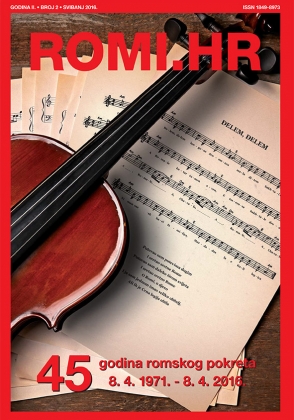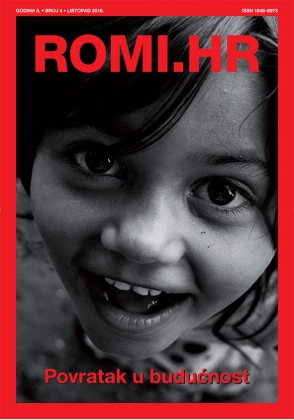Zanimljivosti ROMI.HR
/Zima je jedno od najomiljenih godišnjih doba mnogih Ukrajinaca. U ovom razdoblju slavimo puno praznika koji su vezani s našom kulturom. Jedni od najvažnijih praznika su Nova godina i Božić.
Prijevod: Daria Maracheva
Mnogi ljudi doživljavaju Novu godinu kao vrijeme za novi početak i mogućnost ostvarivanja onog što su oduvijek željeli. Ovo je razdoblje u kojem se osjeća magija u zraku i iskreno se vjeruje da se snovi ostvaruju.
Ukrajinske novogodišnje i Božićne tradicije se prilično razlikuju od ostale Europe. Spomenula sam Novu godinu prije Božića, jer većinu Ukrajinaca čine pravoslavci koji slave Božić 7. siječnja. Dakle, prema našim tradicijama prvo se slavi Nova godina. 7. siječanj je službeni praznik u Ukrajini. Međutim, u Ukrajini se tradicije katoličkih vjernika također uzimaju u obzir. 25. prosinac je isto proglašen državnim praznikom za sve građane Ukrajine.
U prosincu svi Ukrajinci ukrašavaju kuću i postavljaju drvce, koje se u Ukrajini ne zove božićno, nego novogodišnje drvce. Darovi se također poklanjaju za Novu godinu. Za proslavu Nove godine se obično okuplja uža obitelj. Na stolu se najčešće može naći salata Olivier (slično francuskoj salati), salata od rakovica i tzv. “seljodka pod šubom” (haringa pod bundom). Moja obitelj također sprema salatu s piletinom i ananasom, pečenu piletinu s jabukama i losos s vrhnjem. Međutim, proslava Nove godine se poklapa s predbožićnim postom, te one obitelji koje poste, ne mogu jesti sva ova jela.
U ponoć pijemo šampanjac, poželjevši nešto dok sat otkucava 12 puta. Nakon toga mnogi Ukrajinci izlaze van, pripremaju vatromet i gledaju kako se on rasprskava u različitim bojama. Ljudi obično dolaze jedni drugima u gosti i čestitaju Novu godinu. Ujutro se djeca probude i odmah traže poklone ispod novogodišnje jelke. Malo prije blagdana djeca pišu pisma Djedu Morozu (Djedu Mrazu), u kojima govore o svojim uspjesima i traže poklone.
Kad je Božić u pitanju, članovi šire obitelji se okupljaju i zajedno slave ovaj praznik. Naša obitelji obično ide kod bake na večeru. Postoje niz tradicija kojih se treba držati. Post počinje 40 dana prije Božića. Pored Uskrsnog posta to je drugi najvažnjiji post. 6. siječnja je zabranjeno jesti prije večeri, koja se zove Sveta večer.

Za večeru se mora poslužiti 12 jela, koja simboliziraju 12 apostola. Najvažnije jelo na stolu je kutja (leća), odnosno pšenična ili ječmena kaša pomiješana s suhim grožđem, sjemenkama maka, medom i orasima. Na stolu također mora biti uzvar, napitak od suhih jabuka, marelica i višanje, u koji se dodaje vanilija, zvjezdasti anis, cimet, limun i korica naranče i koji se kuha u velikom loncu.
Tokom večere je zabranjeno prepirati se. Svi članovi obitelji trebaju za Božić biti kod kuće, djeca trebaju pomagati odraslima. Također je zabranjeno baviti se kućnim poslovima, rukotvorinama i teškim fizičkim radom.
Za Božićni stol sjedamo kada se na nebu pojavi prva zvijezda. Sveta večer počinje molitvom i paljenjem božićne svijeće. Ukrašavanje stola je također dio tradicije. Na stol se stavlja svježe sijeno i malo žita. Na krajevima stola, ispod stolnjaka, stavljaju se glavice češnjaka. Vjeruje se da će to zaštititi obitelj od bolesti i zloduha. U nekim ukrajinskim regijama na stol se stavlja Diduh. To je snop raži, pšenice ili zobi, koji simbolizira žetvu, bogatstvo i blagostanje.
Važna i nepromjenjiva Božićna tradicija je kolendavanje. Od Svete večeri ili od prvog dana Božića kolendari izlaze van. U rukama imaju veliku zvijezdu, koja se drži na štapiću i prekrivena je pozlaćenim papirom. Zvijezda simbolizira Betlehem, u kojem se rodio Isus. Kolendari su u pravilu djeca odnosno mladi dječaci i djevojčice. Oni obilaze kuće, pjevaju pjesme, a zauzvrat domaćini im daju slatkiše ili sitni novac.
Još jedan ukrajinski drevni božićni običaj se zove Vertep. Vertep (jaslice) je minijaturno lutkarsko kazalište, koje prikazuje scenu rođenja Isusa.
Na Božić je također vrlo popularno proricanje sudbine. Postoji nekoliko vrsta proricanja sudbine. Obično se koristi vosak, mlijeko, svijeće, kosa, snijeg itd. Djevojke vole baviti se gatanjem kako bi saznale tko će im biti suprug.
Nova godina i Božić su vrlo važni praznici u Ukrajini za koje imamo posebne običaje. Tradicije se mogu razlikovati po regijama, ali jedna stvar koja ujedinjuje sve je činjenica da nam ova dva praznika daju priliku provesti vrijeme s ljudima koje volimo, cijeneći svaki trenutak i razmišljajući što je najvažnije u našem životu.

Winter is one of the favorite seasons of many Ukrainians. There are so many holidays in this period which are linked with our culture. One of the most important holidays are New Year’s Day and Christmas.
Every December many people feel that a New year is a new beginning when you have new opportunities to accomplish what you have always wanted. This is the time when you can feel magic in the atmosphere and sincerely believe that the dreams come true.
Ukrainian New Year’s Day and Christmas traditions are quite different from the rest of Europe. I mention New Year’s Day before Christmas, because the majority of Ukrainians are Orthodox and celebrate Christmas on January 7. So, in our tradition the New Year’s Day is celebrated first. January 7 is an official holiday in Ukraine. However, the Catholic population in Ukraine is not left behind. December 25 is an official holiday for everyone too.
In December everyone decorates the house and the celebration tree, we call it New Year’s tree, not Christmas tree. Also, the most desired big presents are given for New Year’s Day. Usually immediate family gathers together on this day. It is very common to prepare Olivier salad (similar to French salad), crab salad and dressed herring. My family also makes a salad with chicken and pineapple, roasted chicken with apples and salmon with cream. However, the time of the New Year’s celebration takes place during pre-Christmas fasting, so those families who fast, they cannot eat all of these meals.
At midnight we drink a glass of champagne, making a wish while the clock is banging 12 times. After that everyone goes out to make the fireworks and look at the sky which explodes in different colors. Usually, people go to their friends’ houses and congratulate them on New Year’s Day. In the morning children wake up and immediately look under the New Year’s tree in search of their presents. Sometime before the holiday they write a letter to Did Moroz (Santa Clause), tell him about their accomplishments and ask for the presents they want.
When it comes to Christmas, the extended family members gather and celebrate it together. In our family we usually go to my grandmother’s house for dinner. There are some traditions which should be followed. Before Christmas normally people should fast for 40 days. This is one of the most important fasting periods, another one goes before Easter. On January 6 people should not eat anything before the evening, which is called the Holy Evening.
12 meals have to be served for dinner, they symbolize 12 apostles. The most important dish on the table is kutia, wheat or barley porridge mixed with raisins, poppy seeds, honey and nuts. Also, there must be some uzvar on the table, it is a combination of dried apples, apricots, and sour cherries along with vanilla, star anise, cinnamon, lemon, and orange zest are boiled in a large pot of water.
During dinner it is prohibited to agrue. All family members should be at home for Christmas, children should help the adults with the holiday preparations. It is also forbidden to engage in household, handicrafts, heavy physical labor.
We sit at the Christmas table all together when the first star appears in the sky. The Holy Evening begins with prayer and lighting a Christmas candle. Table decoration is also a part of the tradition. The table is covered with some fresh hay and a little of grain. On the corners of the table, under the tablecloth, people put a clove of garlic. It is believed that it will protect the family from diseases and evil creatures. In some regions of Ukraine people put Didukh on the table. It is a rye, wheat or oat sheaf, which symbolizes harvest, wealth and prosperity.
An important and unchanging tradition at Christmas is caroling. Carollers go out on the streets, starting either from Holy Evening, or from the first day of Christmas. They often carry with them a large star, fixed on a stick and covered with gilded paper. Such star symbolizes Bethlehem, which symbolizes the birth of Jesus Christ. Usually carollers are children or young boys and girls. They go to the houses, sing carols and the host gives them sweets or some money.
Another ancient Christmas custom in Ukraine is walking with a Vertep. The Vertep (Nativity Scene) is a miniature puppet theatre in a box, in which you can see the whole scene of the moment when Jesus was born.
Also, on Christmas it is very common to do fortune-telling. People want to know their future and there are a few kinds of fortune-telling. Usually people use vax, milk, candles, hair, snow etc for predicting the future. Girls like doing fortune-telling to know who is going to be their husband.
Finally, New Year’s Day and Christmas are very significant holidays in Ukraine and we have special customs for them. Traditions may vary in different regions, but there is one thing which is common for everyone – these two holidays give us an opportunity to spend more time with our beloved and dear ones, appreciating every moment and realizing what is the most important in our life.
 Povratak na zanimljivosti
Povratak na zanimljivosti













